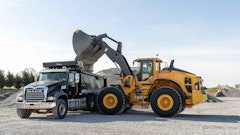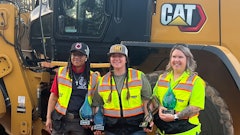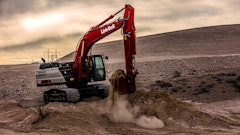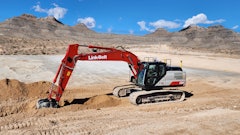
Operator engagement can help control the single largest expense of running a dozer — the undercarriage.
“Operators spend many hours in a machine daily and know what sounds normal,” says Bruce Boebel, senior product manager, tracked products, Komatsu America. “Operators need to listen to their undercarriage. Early detection of problems can reduce wear and save potential ‘victim’ components.” For example, a roller that stops rotating due to a “material packed” undercarriage can start to wear the track chain. Track tension monitoring and daily inspections are also important.
According to Antonio Pela’, engineering and product support manager at Berco of America, three factors greatly impact undercarriage wear. These include ground conditions, the operator’s behavior and the correct machine settings. “A sandy environment reduces undercarriage life more than a rocky application,” he comments. “Sharp turns and quick accelerations wear components off way quicker than smooth operation. Finally, every OEM suggests the correct sag for the track assembly group. Over-tensioning the tracks allows more grip, but wears components faster because of the extra friction involved.”
You need to manage what you can control. “There are controllable and non-controllable variables that determine undercarriage life,” says Tim Nenne, undercarriage market professional, Caterpillar. “There is not much that can be done about the application or underfoot conditions, but track tension and the operator are the two biggest controllable factors.”
He adds, “A good operator means everything when you are trying to achieve the lowest life-cycle costs. A good operator controls and considers the amount of unproductive movements of that track-type machine and maximizes every hour and every mile. A good operator controls the amount of track slip and thinks about not turning the same direction all the time; high-speed reverse; operating with the same side of the machine facing downhill all the time. A good operator understands the undercarriage wear and the things he or she can do to reduce it.”
1. Monitor Track Tension
According to Nenne, tight track is the No. 1 cause of premature track wear on a dozer undercarriage. When you change applications, run the machine for an hour on the new site and then set the track tension to the correct specification. “Re-check the tension as conditions change. For instance, if it rains overnight or during work hours, that will change the amount of packing — track tension will need to be readjusted,” he advises.
A tight track can substantially increase wear on the idlers, links, bushings and sprockets. “Tight track can also damage the sealing system due to high track joint temperatures,” says Nenne. “It is always better to run a bit on the loose side so that if packing increases, there is some margin of error before damage/increased wear begins.”
“Tight track will also rob useful horsepower and increase fuel consumption,” Boebel adds.
But a loose track also creates problems. “It is too loose when the track starts to drag on the top of the roller frame,” says Nenne.
According to Pela’, a loose track group association can cause derailing, chain popping out from the sprocket, unusual impacts between parts and possible chipping and spalling.
The perfect balance between tight and loose stays within the sag recommended by the OEM manufacturer. This requires regular attention. “During the life of the undercarriage, normal wear on parts will naturally allow the tracks to become loose,” says Pela’.
2. Understand Impact of Control Movements
“Modern hydrostatic machines allow operators to turn fast and on a small radius, creating additional stress on the undercarriage as the track group assembly is subjected to additional pulling forces coming from the final drive,” says Pela’. “Those extra efforts tighten the track group assembly and increase the wear rate.”
This is where operator skill makes a big difference. “An operator plays a vital role in determining the overall life of an undercarriage, right behind track tension and underfoot conditions,” says Nenne. Sharp turns and counter rotations increase contact stresses between components. These maneuvers apply high stress to the tracks by braking one side or the other. “If these maneuvers are done more slowly, it does a lot less harm to the undercarriage. As speed increases, the amount of damage increases. A good track inspection will pick up indications that the machine is not being operated correctly.”
“Sharp turns and counter rotation have their place, but must be minimized as they increase stresses in the undercarriage components and reduce expected life,” says Boebel. “Certain wear patterns can be traced back to certain operator techniques.”
High-speed reverse should also be avoided. “On fixed bushing track, the bushing and sprockets will see increased wear rates while running in reverse,” says Nenne. “In reverse, there is sliding wear between the bushing and a sprocket at any speed. But as the speed increases, the amount of load and contact changes, which increases wear rates. Speed also tends to move the bushing out of the root of the sprocket to a point higher on the sprocket tooth, which also changes the contact pattern and results in higher wear.
“Rotating bushing tracks take the sliding component out of the wear equation,” he continues. “Therefore, this type of track is much more tolerant of reverse. Wear rates are almost nothing, even in high-speed reverse.”
“The rotating bushing is crawling on the sprocket, allowing them to always maintain a round shape whether the operator drives forward or backward,” says Pela’. “The rotating bushing is definitely more tolerant on this kind of operation.”
In the past with conventional undercarriages, the bushing would be worn at a much higher rate due to “scuffing” wear around the sprocket. “With the onset of rotating bushing undercarriages such as Komatsu’s PLUS system, this bushing scuff wear is basically eliminated,” says Boebel. “But remember, the faster the speed your undercarriage operates, the faster the wear rate. Speed equates to friction, which equates to heat and — if a trend with an operator — will reduce any undercarriage life.”
3. Pay Attention to Machine Orientation
Side-hill operation accelerates undercarriage wear, especially on the downhill side of the machine.
“A machine operating on side-hill applications will have the link side working constantly against the roller flanges, which creates accelerated wear on both the links and on the roller flange,” says Pela’. “Usually, operating on flat ground wears the undercarriage mostly on the rail surfaces of both the links and rollers.”
Operating on side hills wears off the flanks of the links, which reduces overall link width and therefore the available contact area with the rollers. This leads to increased contact stress when the machine goes back to operate on flat ground, says Pela’. “It is important for the operator to balance the machine orientation as evenly as possible,” he advises. “If feasible, operate half of the working time with one side of the machine facing downhill and the other half facing uphill. This allows for more even wear on both sides.”
The links and rollers on the downhill side will see the higher than normal loads and increased wear rate. “This is also where the track guides and roller flanges on both sides of the machine will work the hardest and see higher wear rates,” says Nenne. “This is why we suggest customers turn the machine around so that both sides of the machine see equal time on the downhill side.”
4. Keep It Clean
The frequency of cleaning required for the undercarriage varies by region and working material properties.
“If you are in Alberta, Canada, and you do not clear your tracks from sticky ‘muskeg’, the material could turn into ‘Canadian Concrete’ overnight, which is difficult to remove,” says Boebel. “A packed track will rob horsepower to the ground and will reduce undercarriage life due to heat and additional stresses. Conversely, if you are grading sand in south Florida, the sand for the most part removes itself.”
“The biggest issue when you do not clean out the undercarriage is that the material dries/hardens or continues to fill the space between the frame and track. The links eventually start to drag across it,” explains Nenne. “This adds an additional contact point for the links and results in higher wear rates. When I conduct customer meetings on undercarriage, I tell them not cleaning the undercarriage can be compared to taking the link assembly, chaining it to the back of a truck and dragging it down a highway. Both result in a high wear rate on the links.”
“Generally speaking, having material stuck between undercarriage components is never good,” says Pela’. “Mud packing over time creates extra layers of material on the undercarriage parts, over-tensioning the track group association and increasing the wear. Sometimes, hard materials like rocks or concrete getting stuck between the roller shells and the rock guards can lock up the rollers, creating wear flat spots on these components. It’s important therefore to keep the undercarriage as clean as possible during the whole life of the machine.”
5. Understand Wear Limits
Eventually, chains, sprockets and idlers need to be replaced.
“I encourage customers to change them out as a set, but as we all know, this is not feasible all the time,” says Nenne. “If you put used rollers on new links, it will reduce the overall life of the link; the same goes for used segments on a new bushing. The issue with this is that the new component and the old component are going to work against each other until their shape matches up again, which results in higher wear rates. Once the component shape matches up, the wear will slow down, but the overall life reduction has happened.”
“The undercarriage components are working as a system,” Pela’ points out. “Every part is related to the other, like in a synchronized mechanism. Whether or not one worn part needs to be replaced is to be carefully evaluated by expert technicians in order to avoid creating more problems than benefits.”
Undercarriage life is driven by wear. “If the operator follows the proper steps, he ends up with an undercarriage system that wears off evenly and that can be used even past 100% wear,” says Pela’. Past the critical point, several things can happen:
Once the wear of the link achieves the maximum, the link pin boss may get stuck against the roller flange, even if the roller shell is worn out at its own max.
The pin and bushing may start popping out from the worn sprocket.
The track adjuster may reach the end of its stroke and not be able to keep the tension on the system anymore, causing the tracks to derail.
“Any of the above factors can cause serious damage and even safety-related issues,” says Pela’. “In general though, the operator can use all of the life out of the undercarriage until it is completely worn out to the point the system will not turn anymore.”
“Bottom line: Trust an undercarriage expert,” Boebel emphasizes. “A contractor needs to establish a good relationship with their OEM product support representative. Doing this will save expense over the long term. The reality is applications are different and customers’ operations are different. OEMs in general spend a lot of time training these distributor product support representatives to be able to recommend the best options for each customer.”



![[Video] TechTalk: Keeping the Undercarriage Clean](https://img.forconstructionpros.com/files/base/acbm/fcp/image/2015/12/default.566afba2a47a6.png?auto=format%2Ccompress&fit=crop&h=75&q=70&w=75)


























